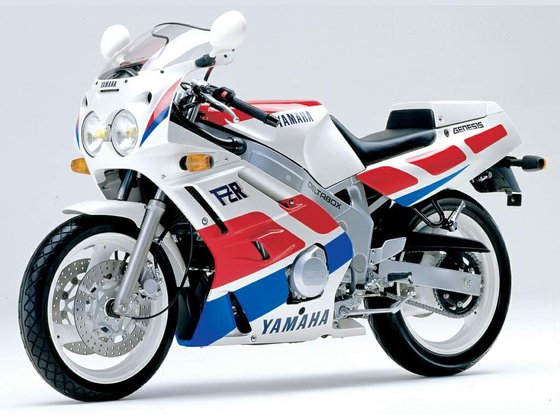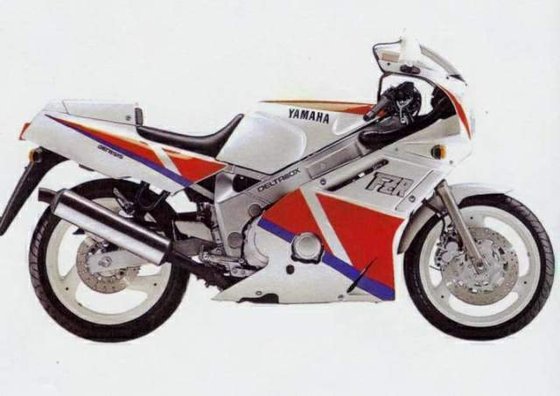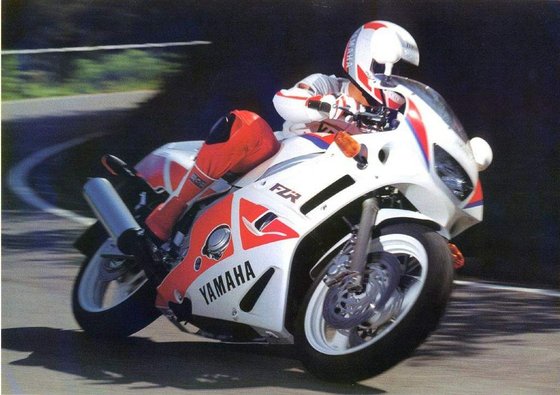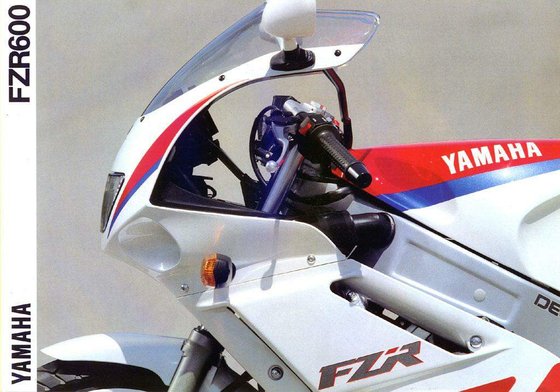Yamaha FZR 600 (1989–1993): A Track-Focused Icon Revisited

Introduction
The Yamaha FZR 600, produced from 1989 to 1993, remains a defining chapter in the history of middleweight sport bikes. Known for its razor-sharp handling and race-bred DNA, the FZR 600 carved out a reputation as a machine that prioritized adrenaline over compromise. Designed during an era when Japanese manufacturers were locked in a Supersport arms race, this bike borrowed technology from its larger sibling, the FZR 1000 Genesis, but distilled it into a lighter, more accessible package.
Swinging a leg over the FZR today, you’re greeted by a no-nonsense riding position and a mechanical symphony from its inline-four engine. Let’s dissect what makes this motorcycle a cult classic—and why it still turns heads in a world of electronic rider aids and hybrid fairings.
Engine Performance: High-Revving Thrills
At the heart of the FZR 600 lies a 599cc liquid-cooled, DOHC inline-four engine. Output varies between 91 HP (66.4 kW) @ 10,500 RPM in unrestricted models and detuned versions (like the "reduced effect" variants) offering as low as 50 HP for markets with strict licensing laws. The engine’s character is unmistakably Yamaha: crisp throttle response, a linear powerband, and a spine-tingling howl as the tachometer climbs past 8,000 RPM.
Key Specs:
- Bore x Stroke: 59.0 x 54.8 mm (2.3 x 2.2 inches)
- Compression Ratio: 12.0:1
- Fuel Delivery: 4 x 38mm Mikuni carburetors
- Top Speed: 237 km/h (147 mph)
The FZR thrives on momentum. Below 6,000 RPM, it’s docile enough for city traffic, but crack the throttle open, and the engine transforms. The midrange surge pulls hard to a redline at 12,000 RPM, though peak power arrives earlier at 10,500 RPM. Riders accustomed to modern fuel-injected bikes might find the carburetors finicky in cold starts, but once warmed up, they deliver a raw, analog experience that’s increasingly rare.
Handling and Chassis: Precision Meets Playfulness
The FZR’s Deltabox frame—a steel twin-spar design—was revolutionary in its day. Paired with a 25-degree rake and 94mm (3.7 inches) of trail, the chassis strikes a balance between stability at speed and flickable agility. On twisty backroads, the bike feels telepathic, diving into corners with minimal input.
Suspension Setup:
- Front: 41mm telescopic forks (130mm/5.1in travel)
- Rear: Monoshock with preload and rebound adjustment (115mm/4.5in travel)
While the suspension is softly sprung for road comfort, it shows its limits under hard braking or mid-corner bumps. Period reviews often criticized the rear shock for being overdamped, leading to chatter on uneven surfaces. Upgrading to aftermarket Öhlins or Fox units (available at MOTOPARTS.store) transforms the ride, tightening up the rear without sacrificing compliance.
Brakes: Dual 298mm discs up front with 2-piston calipers provide ample stopping power, though modern sintered pads improve bite and fade resistance.
Design and Ergonomics: Form Follows Function

The FZR’s bodywork is a time capsule of late-’80s sport bike aesthetics. Early models (1989–1990) featured dual round headlights, while 1991–1993 bikes switched to a single rectangular lamp—a polarizing change that sharpened the bike’s profile. The fairing offers decent wind protection, though taller riders might find the 785mm (30.9-inch) seat height and low clip-ons punishing on long rides.
The cockpit is minimalist: an analog tachometer dominates the display, flanked by a speedometer and warning lights. Storage? Forget it. This is a bike built for riding, not commuting.
Competition: How the FZR Stacks Up
In the early ’90s, the 600cc class was fiercely contested. Here’s how the FZR compared to its rivals:
1. Honda CBR600F
- Strengths: Smoother power delivery, better midrange, and a more versatile riding position.
- Weaknesses: Heavier (208 kg vs. the FZR’s 195 kg dry weight) and less aggressive steering.
- Verdict: The CBR was the “all-rounder,” but the FZR dominated on track days.
2. Kawasaki ZZ-R600
- Strengths: Aerodynamic fairing, 149 mph top speed, and a plush seat.
- Weaknesses: Portly 215 kg wet weight and vague handling.
- Verdict: A touring-focused alternative, not a corner carver.
3. Suzuki GSX600F Katana
- Strengths: Budget-friendly price, comfortable ergonomics.
- Weaknesses: Underpowered engine (27 HP in restricted models), dated chassis.
- Verdict: The Suzuki appealed to pragmatists; the Yamaha to purists.
The FZR’s edge? Its power-to-weight ratio (0.5 HP/kg) and razor-sharp geometry made it a favorite for riders willing to trade comfort for lap times.
Maintenance: Keeping the FZR in Fighting Shape

Owning a 30-year-old sport bike requires diligence. Here’s what to prioritize:
1. Valve Adjustments
- Intake Valve Clearance: 0.11–0.20mm (0.0043–0.0079in)
- Exhaust Valve Clearance: 0.21–0.30mm (0.0083–0.0118in)
Check every 6,000 km (3,728 miles). Tight valves can lead to misfires; loose ones cause noisy operation.
2. Fluids and Filters
- Engine Oil: 2.6L (2.75 quarts) of SAE 20W-40 (with filter). Synthetic blends improve high-RPM protection.
- Coolant: 2.2L (2.3 quarts). Use ethylene glycol-based coolant to prevent corrosion.
- Brake Fluid: DOT 4. Flush annually to maintain lever feel.
3. Carburetor Tuning
- Air Screw Setting: 2.5 turns out.
- Idle RPM: 1,150–1,250 RPM.
Consider a carb sync tool for smoother off-throttle response.
4. Tire Pressures
- Front: 2.3 bar (33 psi)
- Rear: 2.6 bar (38 psi)
Modern radial tires (e.g., Michelin Pilot Power) enhance grip over the original bias-ply Dunlops.
5. Chain and Sprockets
- Stock Gearing: 15/45 (1991–1993 models). Switching to a 14T front sprocket adds snap at the cost of top speed.
- Chain: O-ring 530 chain with 106 links. Clean and lubricate every 500 km (310 miles).
Pro Tip: Upgrade the stock shock and fork springs for ~€500—a small price for transforming the bike’s handling.
Conclusion: A Timeless Sport Bike Experience
The Yamaha FZR 600 isn’t just a relic—it’s a reminder of motorcycling’s analog golden age. Its combination of rev-happy engine, telepathic chassis, and minimalist design creates a ride that’s equal parts demanding and rewarding. While newer bikes boast ABS and traction control, the FZR rewards skill and mechanical sympathy.
For owners, MOTOPARTS.store offers a wealth of upgrades: from stainless steel brake lines to performance air filters. Whether you’re restoring a barn find or tweaking a track weapon, this bike thrives on attention—and always repays it with grins per mile.

The Yamaha FZR 600: Where every ride feels like a time trial.







Specifications sheet
| Engine | |
|---|---|
| Stroke: | Four-stroke |
| Max power: | 66 kW | 89.0 hp |
| Max torque: | 66 Nm |
| Fuel system: | 4 x 38mm Mikuni BDST32 carburetors |
| Max power @: | 10500 rpm |
| Displacement: | 599 ccm |
| Max torque @: | 8500 rpm |
| Bore x Stroke: | 59.0 x 54.8 mm (2.3 x 2.2 in) |
| Configuration: | Inline |
| Cooling system: | Liquid |
| Compression ratio: | 12.0:1 |
| Number of cylinders: | 4 |
| Valves per cylinder: | 4 |
| Dimensions | |
|---|---|
| Wheelbase: | 1425 mm (56.1 in) |
| Dry weight: | 195 |
| Wet weight: | 208 |
| Seat height: | 785 mm (30.9 in) |
| Overall width: | 700 mm (27.6 in) |
| Overall height: | 1155 mm (45.5 in) |
| Overall length: | 2095 mm (82.5 in) |
| Ground clearance: | 135 mm (5.3 in) |
| Fuel tank capacity: | 18 L (4.8 US gal) |
| Reserve fuel capacity: | 3.4 L (0.9 US gal) |
| Drivetrain | |
|---|---|
| Final drive: | chain |
| Gear Ratios: | {'1st': '37/13 (2.846)', '2nd': '37/19 (1.947)', '3rd': '31/20 (1.550)', '4th': '28/21 (1.333)', '5th': '31/26 (1.192)', '6th': '30/27 (1.111)'} |
| Chain length: | 106 |
| Transmission: | 6-speed constant mesh |
| Rear sprocket: | 45 (1991–1993), 46 (1989–1990) |
| Front sprocket: | 15 |
| Primary reduction ratio: | 82/48 (1.708) |
| Secondary reduction ratio: | 45/15 (3.000) |
| Maintenance | |
|---|---|
| Engine oil: | 20W40 |
| Idle speed: | 1150–1250 RPM |
| Brake fluid: | DOT 4 |
| Spark plugs: | NGK CR9E or NGK CR9EIX |
| Spark plug gap: | 0.7–0.8 mm (0.028–0.031 in) |
| Coolant capacity: | 2.2 |
| Forks oil capacity: | 0.87 |
| Rear tire pressure: | 2.6 bar (38 psi) |
| Engine oil capacity: | 2.6 |
| Front tire pressure: | 2.3 bar (33 psi) |
| Engine oil change interval: | Every 5000 km or 2 years |
| Valve clearance (intake, cold): | 0.10–0.20 mm |
| Valve clearance check interval: | 24,000 km (15,000 mi) |
| Valve clearance (exhaust, cold): | 0.20–0.30 mm |
| Chassis and Suspension | |
|---|---|
| Rake: | 25° |
| Frame: | Deltabox aluminum twin-spar |
| Trail: | 94 mm (3.7 in) |
| Rear tire: | 130/70-17 |
| Front tire: | 110/70-17 |
| Rear brakes: | 1 x 214 mm disc, 1-piston caliper |
| Front brakes: | 2 x 298 mm discs, 2-piston calipers |
| Rear suspension: | Rising-rate monoshock, preload and rebound adjustable |
| Front suspension: | 41mm telescopic fork, preload adjustable |
| Rear wheel travel: | 115 mm (4.5 in) |
| Front wheel travel: | 130 mm (5.1 in) |



















